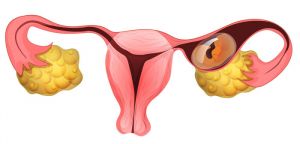During this intervention we only remove the cyst from the ovary.
This type of surgery is indicated in four situations:
- If a liquid-filled functional (ovulation-related) cyst measuring more than 3 cm is present for more than three months.
- Functional (ovulation-related) ovarian cyst measuring more than 6 cm.
- Non-functional, but benign cysts:
- In an emergency (ovarian torsion, ruptured cyst with haemorrhage or peritonitis)
This type of surgical procedure is usually performed under general anaesthesia and using a laparoscopic approach (keyhole surgery).
Rarely laparotomy (involving a large incision through the abdominal wall) may be necessary for anatomical reasons (big cyst, suspicion).
During cystectomy the ovary is generally not affected, the future ovarian function and fertility will not be compromised.
Every removed cyst is subjected to macroscopic analysis by a pathologist. All results will be communicated during your post-surgery appointment.
Cystectomy by laparoscopic approach can be performed in one day (with a maximum of one night hospital stay).
Complete recovery is obtained after 1-2 weeks.
During a diagnostic process of fertility problems, we perform a hysterosalpingography (radiologic procedure to explore the uterus and Fallopian tubes). If this exam reveals occlusion of the tubes, a surgical repair can be proposed.
Laparoscopy is used to make a precise diagnosis and correct treatment at the same time.
1- Blue dye tubal injection:
When we inject dyed water into the uterus, we can observe its pathway through the Fallopian tubes into the abdominal cavity, visualising the obstructions or any other abnormalities of the tube.
2- Ovarian drilling:
In the case of polycystic ovarian syndrome, drilling little holes into the ovarian tissue can provoke spontaneous ovulation.
3- Adhesiolysis between pelvic organs:
In certain cases sterility is due to pelvic adherences (previous surgery, infection, endometriosis).
Laparoscopy diagnostics with blue dye test and the loosening of adherences can result in obtaining spontaneous pregnancy.
4- Tubal re-anastomosis:
In most cases tubal ligation is definite, but it may occasionally become necessary to try to achieve a re-anastomosis.
After incision and resection of the occluded parts of the tube, we insert a guide into the tubal canal. Once the two channels are connected, we perform an edge-to-edge suture with a very thin needle.
This surgery is carried out by laparoscopy, but the outcome is very variable. It still remains a good alternative to in vitro fertilisation techniques.
The intervention can be performed in one day or with one night hospital stay. The total recovery takes up to 2 weeks.
Tubal ligation is a definite and irreversible way of contraception. During this surgical procedure we dissect the tube and suture the two surgical edges with the aim of obstructing the pathways from both sides. Tubal ligation can be performed by two different surgical approaches:
1- Laparoscopic approach:
The intervention is carried out under general anesthesia; two clips are placed on each of the tubes.
The surgery can be done with a follow-up on the same day, the complete recovery is one week.
2- Hysteroscopic approach:
This technique can be used to put a little metallic sphere implant into each tubal orifices. After three months this implant generates scar tissue and completely blocks the tubal passage.
A pregnancy is ectopic if it develops outside the uterine cavity. Most frequently it is found in the Fallopian tube.
The frequency of this condition is as high as 0.5 % of all births.
The main symptom is pelvic pain with or without vaginal bleeding.

- A previous ectopic pregnancy
- History of pelvic inflammatory disease
- History of a surgical procedure targeting the fallopian tubes.
Treatment :
Medical treatment is possible, but in most cases surgery is necessary.
The intervention is carried out by laparoscopy, under general anesthesia. During the intervention the surgeon will decide to either:
- expulse the pregnancy from the tubes using mechanical pressure.
- open up the tube and remove the ectopic pregnancy
- Or to extract the tube itself, if too damaged or in the case of heavy bleeding.
In most cases a one-night hospital stay is sufficient, and complete recovery is obtained after 1 to 2 weeks.
